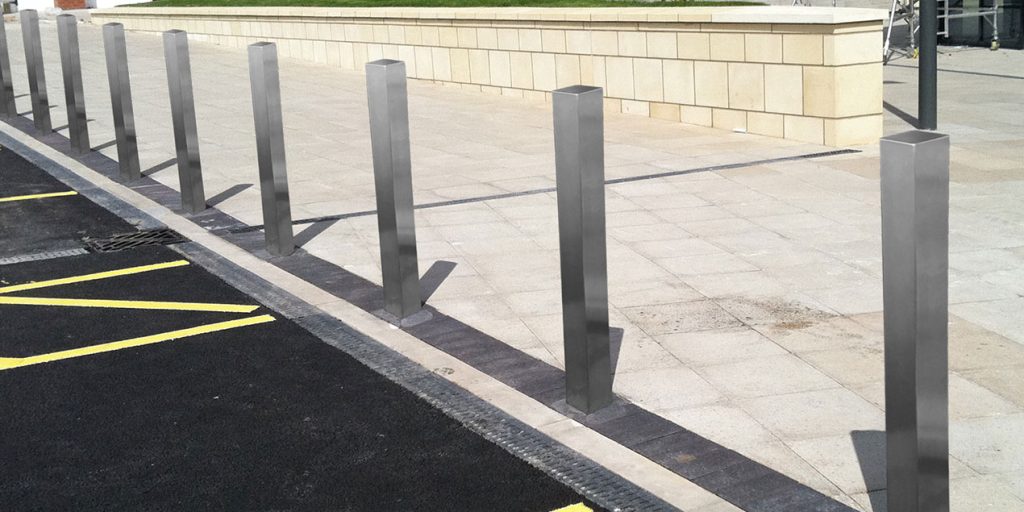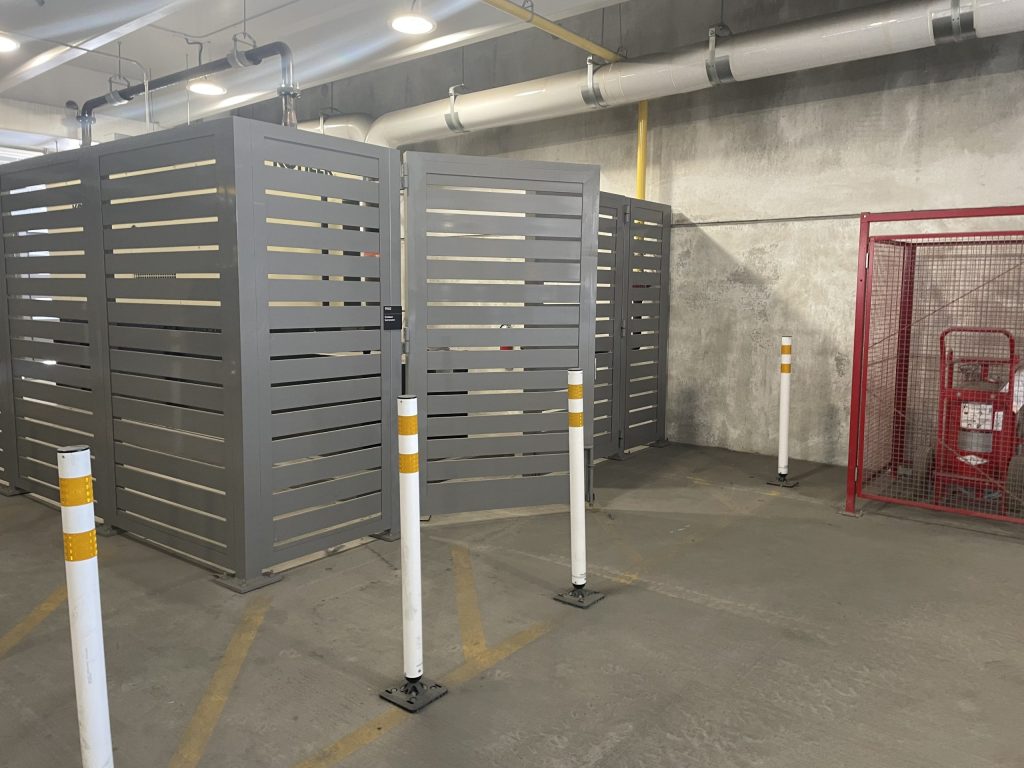How Bollards Protect Commercial Property

When it comes to modern perimeter security, bollards are indispensable. Although not as massive and protective as gates and fencing, these vertical posts — frequently installed in lines around parking lots, fire lanes, private entrances, and construction zones — go a long way in improving on-campus safety. The last thing property owners need is infrastructure damage caused by fast-moving adversaries, or traffic wandering into an area that — either temporarily or permanently — is off limits to those without authorization. For that reason, bollards are essential for airports, factories, industrial parks, corporate headquarters, and other commercial hubs. In today’s article, we’ll provide a basic overview of bollards, the ways in which they protect commercial property, and why PalmSHIELD is your go-to provider for these fixtures.
How do bollards help protect my facility? From what threats?
Bollards are short posts, composed of sturdy material, that act as physical barriers. Typically they are installed to prevent automobiles from entering restricted zones, their sturdy build and compact arrangement physically blocking the girth of approaching cars. Bollards come in several types and styles, in order to accommodate a broader variety of security needs:
- Preventing vehicle collisions. Bollards act as physical barriers that prevent vehicles from accidentally or intentionally colliding with buildings, pedestrians, or outdoor assets. For instance, in busy urban areas, they can stop cars from mounting sidewalks, protecting pedestrians and storefronts from damage.
- Deterring ram-raiding. Ram-raiding is a form of burglary where vehicles are used to crash through doors or windows to gain access. Crash-rated bollards installed at entrances can thwart such attempts, safeguarding businesses from theft and structural damage.
- Controlling traffic flow. Bollards help manage the flow of vehicles in crowded areas. By clearly delineating pedestrian zones from vehicle lanes, they reduce the risk of accidents and ensure orderly movement.
- Protecting outdoor assets. Properties with outdoor features such as seating, sculptures, or fountains benefit greatly from bollards. These barriers shield these assets from accidental damage caused by vehicles.
- Enhancing perimeter security. Critical infrastructure, such as power stations, airports, and data centers, require robust perimeter security. Bollards act as the first line of defense, preventing unauthorized vehicles from breaching these sensitive areas.
- Mitigating terrorist attacks. In high-risk areas, bollards are a crucial counter-terrorism measure. Crash-rated bollards can stop vehicles loaded with explosives, protecting people and buildings from catastrophic harm.
- Safeguarding pedestrian zones. With the rise of pedestrian-only streets and outdoor dining spaces, bollards ensure these areas remain vehicle-free, creating a safer and more enjoyable environment for people.

Types of Bollards
PalmSHIELD sells four distinct bollard types, allowing you the flexibility to choose the one best suited to your security needs.
- Surface Mounted Bollards. PalmSHIELD’s surface mounted bollards are a top choice for airports, parking garages, construction zones, and other areas where security perimeter frequently changes. These posts are, as the name suggests, attached to surface rather than driven into place. As such, they can be easily relocated as, say, construction perimeters change throughout the course of the job.
- Embedded Bollards. Embedded bollards are driven into the strata of your installation site; as such, they have increased strength and resilience. Embedded bollards are a more permanent installation, often used to safeguard parking lots, architectural screening, and street-level infrastructure.
- Removable Bollards. If you need perimeter security on a short-term basis, little no further than PalmSHIELD’s removable bollards. Set up these bollards and relocate them as perimeter boundaries change. A must for flea markets, street fairs, parades, and car shows.
- Collapsible Bollards. Collapsible bollards are recommended for protecting vehicle access roads, fire lanes, and trails that are temporarily off limits.
Benefits of bollards
- Cost-effective protection. Bollards offer a cost-effective way to protect property compared to repairing damage caused by vehicle collisions or theft. Their durability ensures long-term performance with minimal maintenance.
- Aesthetic integration. Modern bollards are available in various designs, colors, and materials, allowing them to blend seamlessly into the surrounding architecture. This ensures that safety doesn’t come at the expense of aesthetics.
- Ease of installation. Depending on the type, bollards can be installed quickly and efficiently. Removable and retractable bollards, in particular, offer flexibility for areas requiring temporary access.
- Versatility. Bollards cater to a wide range of needs, from pedestrian safety and traffic control to high-security applications. This versatility makes them suitable for diverse settings, including residential neighborhoods, commercial zones, and industrial sites.
Applications of Bollards
- Retail and commercial properties. Bollards are often installed outside storefronts to protect them from accidental vehicle crashes and ram-raiding attempts. They also guide customer traffic in parking areas.
- Public spaces. Parks, plazas, and sidewalks use bollards to define pedestrian zones and protect visitors from vehicles. Decorative bollards enhance the ambiance of these spaces while providing safety.
- Airports and train stations. High-traffic transportation hubs rely on bollards to manage vehicle access, protect terminals, and ensure the safety of passengers.
- Schools and playgrounds. Bollards create safe zones around schools and playgrounds by keeping vehicles at a safe distance, protecting children from accidents.
- Industrial facilities. Industrial sites often require bollards to secure perimeters, protect equipment, and guide vehicles safely through loading and unloading zones.
Factors to Consider When Choosing Bollards
- Purpose. Identify the primary function of the bollard—whether it’s for security, traffic management, or aesthetic purposes. This will determine the type of bollard needed.
- Design. Choose a design that complements the surrounding environment. Decorative bollards are ideal for public spaces, while functional designs work best in industrial settings.
- Installation requirements. Consider whether fixed, removable, or retractable bollards are best suited for the location. The installation process and cost may vary based on this choice.
- Crash rating. For high-security applications, ensure the bollards meet crash-rating standards to withstand vehicle impacts.
Bollards are more than just barriers; they are vital tools for protecting property, ensuring safety, and enhancing urban design. Whether used to prevent accidents, deter crime, or secure perimeters, bollards play a crucial role in modern infrastructure. With various types, designs, and applications, they offer a flexible and cost-effective solution for a wide range of needs. Investing in the right bollards not only safeguards property but also contributes to a safer and more organized environment for everyone.
If you need bollards for security, look no further than PalmSHIELD! Contact our sales team today to discuss which bollard type works best for you!
